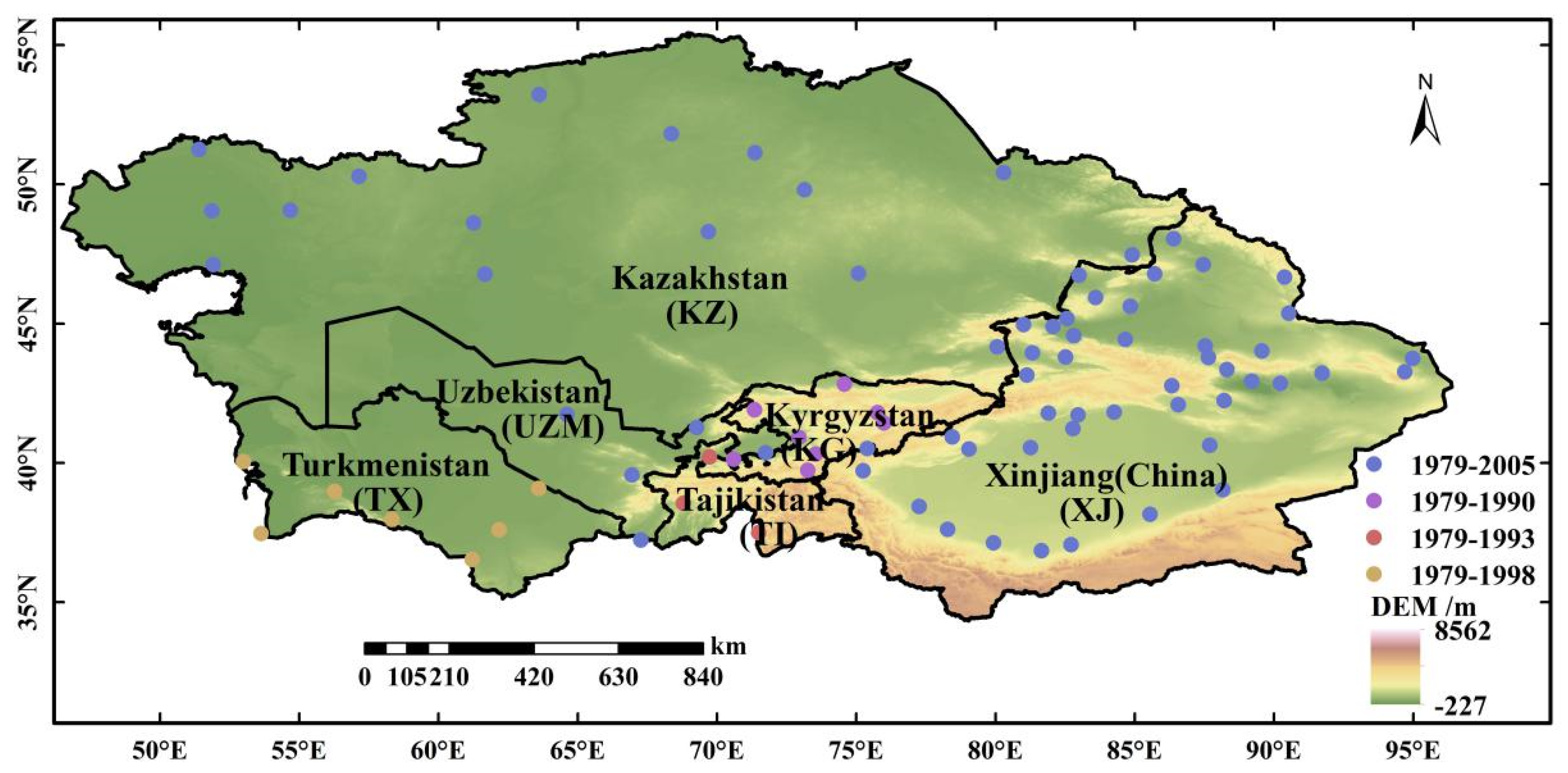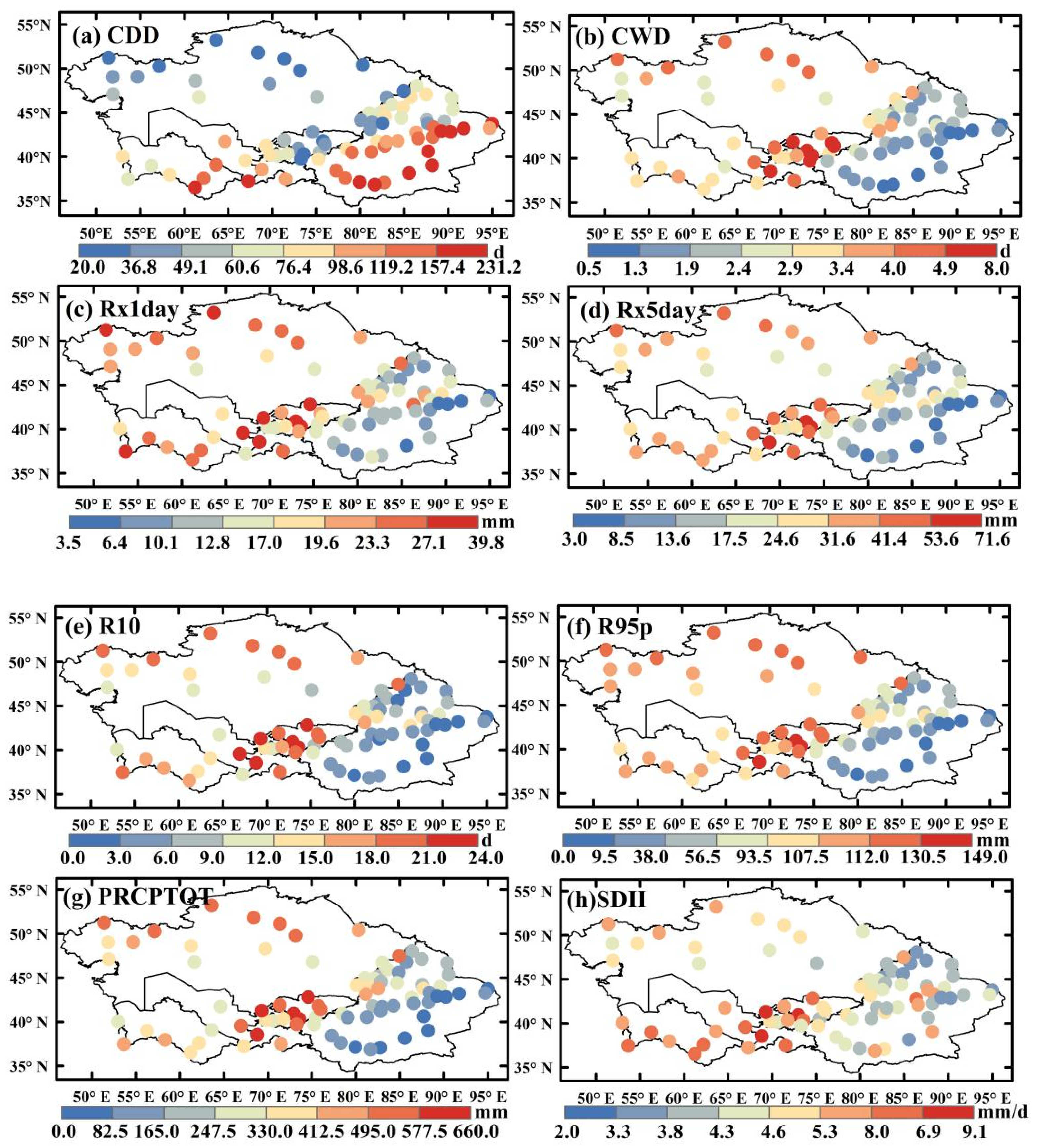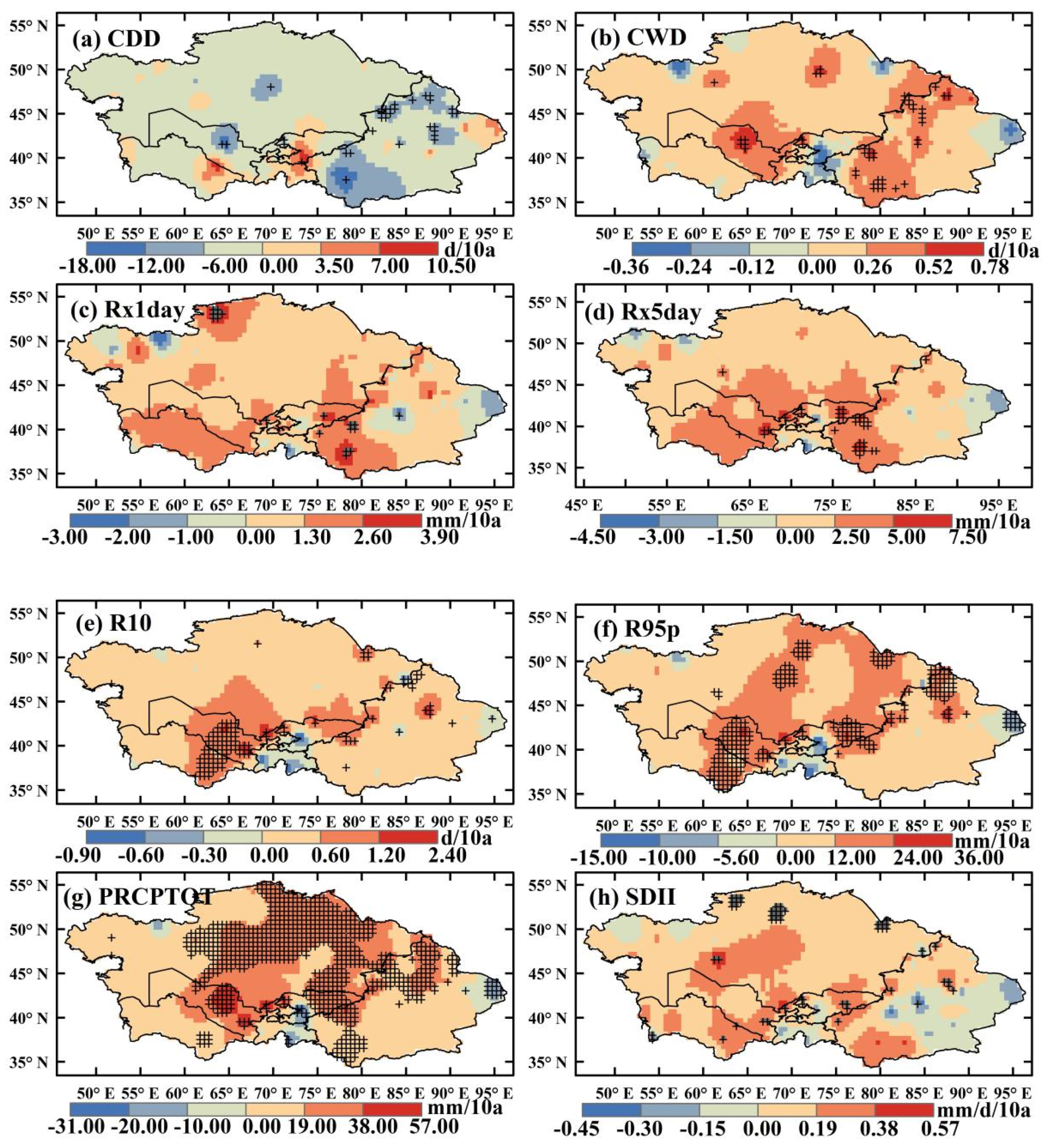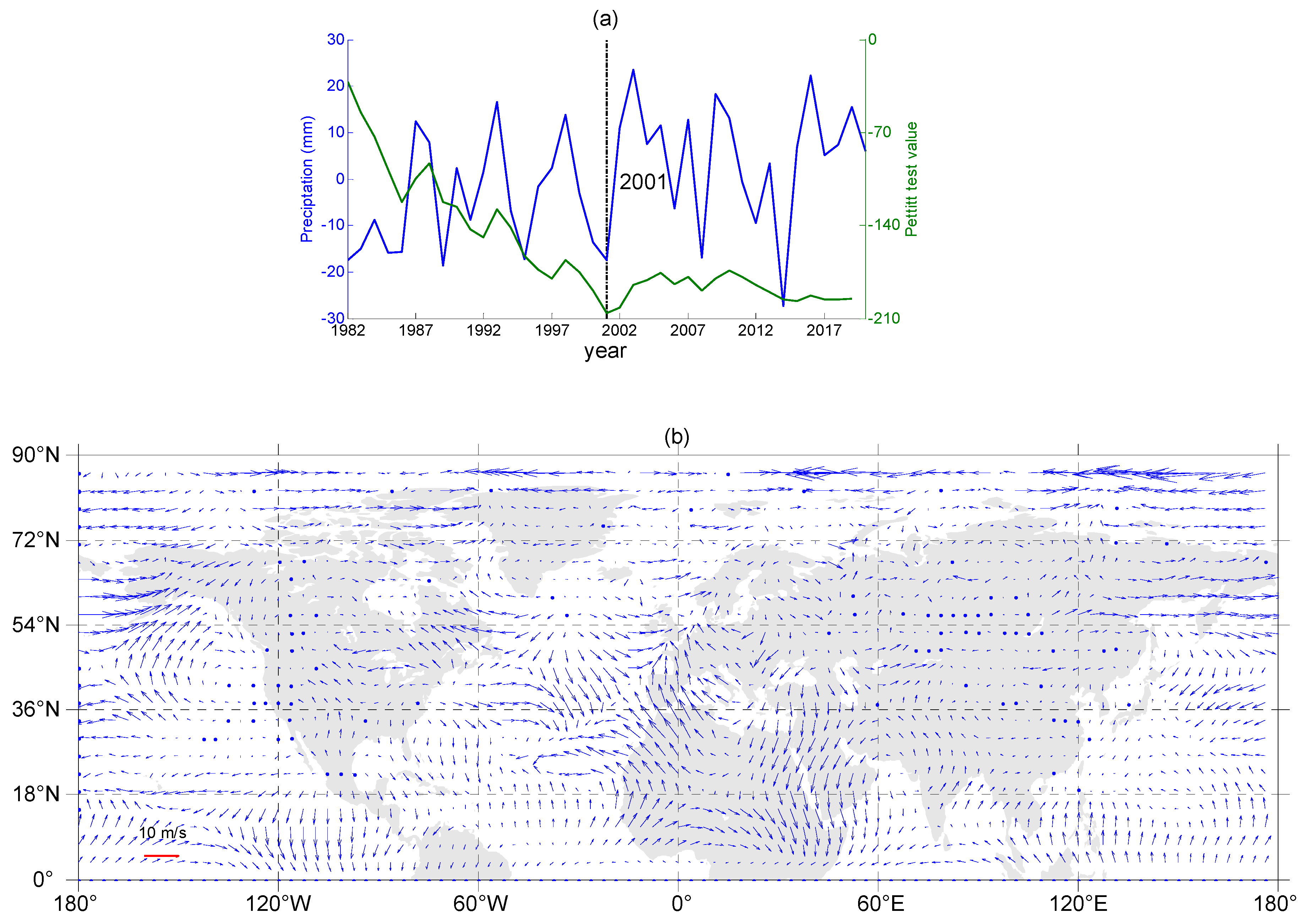Spatial and Temporal Variations of Extreme Precipitation in Central Asia during 1982–2020
Abstract
:1. Introduction
2. Data and Methodology
2.1. Study Area
2.2. Data
2.3. Method
2.3.1. Indices for Precipitation Extremes
2.3.2. Evaluating Methods
2.3.3. Pettitt Test
2.3.4. Trend Estimation Methods
3. Results
3.1. Changes of Precipitation Indices during 1979–2005
3.2. Applicability Evaluation of Reanalysis Datasets for Precipitation Indices
3.3. Temporal and Spatial Variations of Precipitation Indices in CA during 1982–2020
3.4. Background Changes in Atmospheric Circulation
4. Conclusions and Discussions
Author Contributions
Funding
Institutional Review Board Statement
Informed Consent Statement
Data Availability Statement
Conflicts of Interest
Abbreviations
| CA | Central Asia |
| CPC | Climate Prediction Center |
| ERA | ERA Interim |
| KZ | Kazakhstan |
| KG | Kyrgyzstan |
| TI | Tajikistan |
| TX | Turkmenistan |
| UZM | Uzbekistan |
| XJ | Xinjiang Uygur Autonomous Region in China |
| CDDs | Consecutive dry days |
| CWDs | Consecutive wet days |
| Rx1day | Max1-day precipitation amount |
| Rx5day | Max5-day precipitation amount |
| R10 | Number of heavy precipitation days |
| R95p | Very wet days |
| PRCPTOT | Annual total precipitation in wet days |
| SDII | Simple precipitation intensity index |
| CCs | Correlation coefficients |
| RMSE | Root-mean-squared error |
| OBS | Observation |
References
- Watts, G.; Battarbee, R.W.; Bloomfield, J.P.; Crossman, J.; Daccache, A.; Durance, I.; Elliott, J.A.; Garner, G.; Hannaford, J.; Hannah, D.M.; et al. Climate change and water in UK-past changes and future prospects. Prog. Phys. Geogr. 2015, 39, 6–28. [Google Scholar] [CrossRef]
- Hossain, F.; Jeyachandran, I.; Pielke Sr, R. Dam safety effects due to human alteration of extreme precipitation. Water Resour. Res. 2010, 46, W03301. [Google Scholar] [CrossRef]
- Hossain, F.; Arnold, J.; Beighley, E.; Brown, C.; Burian, S.; Chen, J.; Shahrbanou, M.; Mitra, A.; Niyogi, D.; Pielke Sr, R.; et al. Local-to-regional landscape drivers of extreme weather and climate: Implications for water infrastructure resilience. J. Hydrol. Eng. 2015, 20, 02515002. [Google Scholar] [CrossRef] [Green Version]
- Shepherd, J.M.; Shem, W.; Manyin, M.; Hand, L.; Messen, D. Modeling Urban effects on the precipitation component of the water cycle. In Geospatial Analysis and Modeling of Urban Environments; Jiang, B., Yao, X., Eds.; Springer Book Series and GIScience: Dordrecht, Netherlands, 2010; p. 445. [Google Scholar]
- Shepherd, J.M.; Burian, S.J.; Jin, M.; Liu, C.; Johnson, B. Two decades of urban hydroclimatological studies have yielded discovery and societal benefits. In Satellite Precipitation Measurement, Advances in Global Change Research; Levizzani, V., Kidd, C., Kirschbaum, D., Kummerow, C., Nakamura, K., Turk, F., Eds.; Springer: Cham, Switzerland, 2020; Volume 67. [Google Scholar]
- National Research Council. Radiative Forcing of Climate Change: Expanding the Concept and Addressing Uncertainties; The National Academies Press: Washington, DC, USA, 2005; p. 208. [Google Scholar]
- Siegfried, T.; Bernauer, T.; Guiennet, R.; Sellars, S.; Robertson, A.W.; Mankin, J.; Bauer-Gottwein, P.; Yakovlev, A. Will climate change exacerbate water stress in Central Asia? Clim. Chang. 2012, 112, 881–899. [Google Scholar] [CrossRef]
- Zhao, J.; Su, B.; Mondal, S.K.; Wang, Y.; Tao, H.; Jiang, T. Population exposure to extreme precipitations in the Indus River Basin at 1.5 °C 2.0 °C and 3.0 °C warming levels. Adv. Clim. Chang. Res. 2021, 12, 199–209. [Google Scholar] [CrossRef]
- Pielke, R., Jr. The Rightful Place of Science: Disasters and Climate Change; Arizona State University’s Consortium for Science, Policy, & Outcomes: Arizona, AZ, USA, 2014; p. 124. [Google Scholar]
- Chen, F.; Huang, W.; Jin, L.; Chen, J.; Wang, J. Spatiotemporal precipitation variations in the arid Central Asia in the context of global warming. Sci. China Earth Sci. 2011, 54, 1812–1821. [Google Scholar] [CrossRef]
- Grave, P.; Orlowsky, B.; Mueller, B.; Sheffiled, J.; Reichstein, M.; Senevratne, S.I. Global assessment of trends in wetting and drying over land. Nat. Geosci. 2014, 7, 716–742. [Google Scholar] [CrossRef]
- Sun, F.; Roderick, M.L.; Farquhar, G.D. Changes in the variability of global land precipitation. Geophys. Res. Lett. 2012, 39, L19402. [Google Scholar] [CrossRef] [Green Version]
- Donat, M.G.; Lowry, A.L.; Alexander, L.V.; O’Gorman, P.A.; Maher, N. More extreme precipitation in the world’s dry and wet regions. Nat. Clim. Chang. 2017, 6, 154–158. [Google Scholar] [CrossRef] [Green Version]
- Wang, H.; Chen, Y.; Xun, S.; Lai, D.; Fan, Y.; Li, Z. Changes in daily climate extremes in the arid area of northwestern China. Theor. Appl. Clim. 2013, 112, 15–28. [Google Scholar] [CrossRef]
- IPCC. 2021: Summary for Policymakers. In Climate Change 2021: The Physical Science Basis. Contribution of Working Group I to the Sixth Assessment Report of the Intergovernmental Panel on Climate Change; Cambridge University Press: Cambridge, UK, 2021; in press. [Google Scholar]
- Xu, L.; Zhou, H.; Du, L.; Yao, H.; Wang, H. Precipitation trends and variability from 1950 to 2000 in arid lands of Central Asia. J. Arid Land 2015, 7, 514–526. [Google Scholar] [CrossRef] [Green Version]
- Hu, Z.; Zhou, Q.; Chen, X.; Cheng, Q.; Wang, S.; Li, J. Variations and changes of annual precipitation in Central Asia over the last century. Int. J. Climatol. 2017, 37 (Suppl. 1), 157–170. [Google Scholar] [CrossRef]
- Zhang, M.; Chen, Y.; Shen, Y.; Chen, J.; Zhao, Y.; Tuoliewubieke, D.; Li, J.; Yang, L.; Mao, W. Changes of extreme precipitation in arid Central Asia. Quat. Int. 2017, 436, 16–27. [Google Scholar] [CrossRef]
- Zhang, M.; Chen, Y.; Shen, Y.; Li, B. Tracking climate change in Central Asia through temperature and precipitation extremes. J. Geog. Sci. 2019, 20, 3–28. [Google Scholar] [CrossRef] [Green Version]
- Reinhard, S.; Lüthi, D.; Vidale, P.L.; Schär, C. The precipitation climate of central Asia—Intercomparison of observational and numerical data sources in a remote semiarid region. Int. J. Climatol. 2008, 28, 295–314. [Google Scholar]
- Donat, M.G.; Sillmann, J.; Wild, S.; Alexander, L.V.; Lippmann, T.; Zwiers, F.W. Consistency of Temperature and Extreme precipitations across Various Global Gridded in Situ and Reanalysis Datasets. J. Clim. 2014, 27, 5017–5035. [Google Scholar] [CrossRef]
- Hu, L.; Huang, G.; Hu, K. The performance of multiple datasets in characterizing the changes of extreme air temperature over China during 1979 to 2012. Theor. Appl. Climatol. 2018, 133, 619–632. [Google Scholar] [CrossRef]
- Zhou, B.; Xu, Y.; Wu, J.; Dong, S.; Shi, Y. Changes in temperature and extreme precipitation indices over China: Analysis of a high-resolution grid dataset. Int. J. Climatol. 2016, 36, 1051–1066. [Google Scholar] [CrossRef]
- Song, S.; Bai, J. Increasing winter precipitation over arid Central Asia under global warming. Atmosphere 2016, 7, 139. [Google Scholar] [CrossRef] [Green Version]
- Hu, Z.; Hu, Q.; Zhang, C.; Chen, X.; Li, Q. Evaluation of reanalysis, spatially-interpolated and satellite remotely-sensed precipitation datasets in Central Asia. J. Geophys. Res. Atmos. 2016, 121, 5648–5663. [Google Scholar] [CrossRef] [Green Version]
- Chen, X.; Wang, S.; Hu, Z.; Zhou, Q.; Hu, Q. Spatiotemporal characteristics of seasonal precipitation and their relationships with ENSO in Central Asia during 1901–2013. J. Geog. Sci. 2018, 28, 1341–1368. [Google Scholar] [CrossRef] [Green Version]
- Cao, L.; Chen, X.; Zhang, C.; Kurban, A.; Yuan, X.; Pan, T.; Maeyer, P.D. The Temporal and Spatial Distributions of the Near-Surface CO2 Concentrations in Central Asia and Analysis of Their Controlling Factors. Atmophere 2017, 8, 85. [Google Scholar] [CrossRef] [Green Version]
- Yao, J.; Chen, J.; Zhang, T.; Dilinuer, T.; Mao, W. Stationarity in the variability of arid precipitation: A case study of arid Central Asia. Adv. Clim. Chang. Res. 2021, 12, 172–186. [Google Scholar] [CrossRef]
- He, H.; Luo, G.; Cai, P.; Hamdi, R.; Termonia, P.; Maeyer, P.D.; Kurban, A.; Li, J. Assessment of Climate Change in Central Asia from 1980 to 2100 Using the Köppen-Geiger Climate Classification. Atmophere 2021, 12, 123. [Google Scholar] [CrossRef]
- Li, Z.; Chen, Y.; Li, W.; Deng, H.; Fang, G. Potential impacts of climate change on vegetation dynamics in Central Asia. J. Geophys. Res. Atmos. 2015, 120, 12345–12356. [Google Scholar] [CrossRef]
- Dee, D.P.; Uppala, S.M.; Simmons, A.J.; Berrisford, P.; Poli, P.; Kobayashi, S.; Andrae, U.; Balsamo, G.; Bauer, P.; Bechtold, P.; et al. The ERA-Interim reanlysis: Configuration and performance of the data assimilation system. Q. J. R. Meteorol. Soc. 2011, 137, 553–597. [Google Scholar] [CrossRef]
- Frich, P.; Alexander, L.V.; Della-Marta, P.; Gleason, B.; Haylock, M.; Klein Tank, A.M.G.; Peterson, T. Observed coherent changes in climatic extremes during the second half of the twentieth century. Clim. Res. 2002, 19, 193–212. [Google Scholar] [CrossRef] [Green Version]
- Hu, Z.; Zhou, Q.; Chen, X.; Li, J.; Li, Q.; Chen, D.; Liu, W.; Yin, G. Evaluation of three global gridded precipitation data sets in central Asia based on rain gauge observation. Int. J. Climatol. 2018, 38, 3475–3493. [Google Scholar] [CrossRef]
- Guo, H.; Chen, S.; Bao, A.; Hu, J.; Gebregiorgis, A.S.; Xue, X.; Zhang, X. Inter-comparison of high-resolution satellite precipitation products over central Asia. Remote Sens. 2015, 7, 7181–7212. [Google Scholar] [CrossRef] [Green Version]
- Pettitt, A.N. A non-parametric approach to the changepoint problem. J. R. Stat. Soc. C (Appl. Stat.) 1979, 28, 126–135. [Google Scholar]
- Mallakpour, I.; Gabriele, V. A simulation study to examine the sensitivity of the Pettitt test to detect abrupt changes in mean. Hydrol. Sci. J. 2016, 61, 245–254. [Google Scholar] [CrossRef] [Green Version]
- Herrera-Grimaldi, P.; García-Marín, A.; Ayuso-Muñoz, J.L.; Flamini, A.; Morbidelli, R.; Ayuso-Ruíz, J.L. Detection of trends and break points in temperature: The case of Umbria (Italy) and Guadalquivir Valley (Spain). Acta Geophys. 2018, 66, 329–343. [Google Scholar] [CrossRef]
- Amiri, M.A.; Mesgari, M.S. Modeling the spatial and temporal variability of precipitation in northwest Iran. Atmosphere 2017, 8, 254. [Google Scholar] [CrossRef] [Green Version]
- Huang, N.E.; Wu, Z. A review on Hilbert-Huang Transform: The method and its applications on geophysical studies. Rev. Geophys. 2008, 46, RG2006. [Google Scholar] [CrossRef] [Green Version]
- Zhong, L.H.; Hua, L.J.; Yao, Y.; Feng, J.M. Interdecadal aridity variations in Central Asia during 1950–2016 regulated by oceanic conditions under the background of global warming. Clim. Dyn. 2021, 56, 3665–3686. [Google Scholar] [CrossRef]
- Wei, W.G.; Yan, Z.W.; Li, Z. Influence of Pacific Decadal Oscillation on global precipitation extremes. Environ. Res. Lett. 2021, 16, 044031. [Google Scholar] [CrossRef]







| Indice | Descriptive Name | Definitions | Unit |
|---|---|---|---|
| CDDs | Consecutive dry days | Annual maximum number of consecutive days with daily precipitation <1 mm | d |
| CWDs | Consecutive wet days | Annual maximum number of consecutive days with daily precipitation ≥1 mm | d |
| Rx1day | Max1-day precipitation amount | Annual maximum 1day precipitation | mm |
| Rx5day | Max5-day precipitation amount | Annual maximum consecutive 5 days precipitation | mm |
| R10 | Number of heavy precipitation days | Annual count of days when daily precipitation ≥10 mm | d |
| R95p | Very wet days | Annual total precipitation when daily precipitation >95th percentile | mm |
| PRCPTOT | Annual total precipitation in wet days | Annual total precipitation in wet days with daily precipitation ≥1 mm | mm |
| SDII | Simple precipitation intensity index | Annual total precipitation in wet days divided by number of these days with daily precipitation ≥1 mm | mm/d |
| Indices | ERA-OBS (1979–2005) | ERA-OBS (1982–2005) | CPC-OBS (1979–2005) | CPC-OBS (1982–2005) |
|---|---|---|---|---|
| CDDs | 0.58 ** | 0.58 ** | 0.71 ** | 0.93 ** |
| CWDs | 0.40 * | 0.40 * | 0.26 | 0.60 ** |
| Rx1day | 0.63 ** | 0.63 ** | 0.42 * | 0.78 ** |
| Rx5day | 0.61 ** | 0.63 ** | 0.51 ** | 0.82 ** |
| R10 | 0.73 ** | 0.75 ** | 0.69 ** | 0.85 ** |
| R95p | 0.83 ** | 0.84 ** | 0.59 ** | 0.90 ** |
| PRCPTOT | 0.84 ** | 0.84 ** | 0.57 ** | 0.91 ** |
| SDII | 0.64 ** | 0.68 ** | 0.66 ** | 0.81 ** |
| Indices | CC (ERA-OBS) | RMSE (ERA-OBS) | CC (CPC-OBS) | RMSE (CPC-OBS) |
|---|---|---|---|---|
| CDDs | 0.62 ** | 34.82 | 0.79 ** | 30.81 |
| CWDs | 0.25 ** | 3.01 | 0.60 ** | 1.28 |
| Rx1day | 0.34 ** | 8.58 | 0.59 ** | 8.24 |
| Rx5day | 0.43 ** | 17.00 | 0.68 ** | 10.58 |
| R10 | 0.36 ** | 6.66 | 0.73 ** | 1.71 |
| R95p | 0.46 ** | 70.13 | 0.73 ** | 31.53 |
| PRCPTOT | 0.51 ** | 195.40 | 0.84 ** | 52.13 |
| SDII | 0.32 ** | 1.08 | 0.60 ** | 1.03 |
Publisher’s Note: MDPI stays neutral with regard to jurisdictional claims in published maps and institutional affiliations. |
© 2021 by the authors. Licensee MDPI, Basel, Switzerland. This article is an open access article distributed under the terms and conditions of the Creative Commons Attribution (CC BY) license (https://creativecommons.org/licenses/by/4.0/).
Share and Cite
Tian, Y.; Yan, Z.; Li, Z. Spatial and Temporal Variations of Extreme Precipitation in Central Asia during 1982–2020. Atmosphere 2022, 13, 60. https://doi.org/10.3390/atmos13010060
Tian Y, Yan Z, Li Z. Spatial and Temporal Variations of Extreme Precipitation in Central Asia during 1982–2020. Atmosphere. 2022; 13(1):60. https://doi.org/10.3390/atmos13010060
Chicago/Turabian StyleTian, Yalin, Zhongwei Yan, and Zhen Li. 2022. "Spatial and Temporal Variations of Extreme Precipitation in Central Asia during 1982–2020" Atmosphere 13, no. 1: 60. https://doi.org/10.3390/atmos13010060
APA StyleTian, Y., Yan, Z., & Li, Z. (2022). Spatial and Temporal Variations of Extreme Precipitation in Central Asia during 1982–2020. Atmosphere, 13(1), 60. https://doi.org/10.3390/atmos13010060






